by Editor | Aug 29, 2011 | Luxury Travel
Article and photos by Josette King
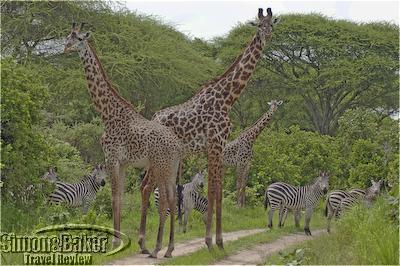
Zebras and giraffes are unconcerned by our presence
Tanzania is the largest country in East Africa, with a landmass of 342,000 square miles (885, 800 square kilometer), of which more than 25 percent is in national parks, game reserves and other wildlife management protected areas, (i.e. over 80, 000 square miles or 207,000 square kilometers). Yet, mention Tanzania, and even the most casual armchair traveler perks up thinking Serengeti, Ngorongoro Crater! These are arguably some of the best-known and most visited safari destinations in the country, and on the African continent. But together, these two legendary northern Tanzania national parks account for less than ten percent of the total preserved land in the country. What of the remainder then? I wondered.
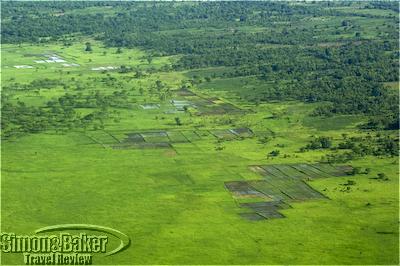
Aerial view of western Tanzania
It didn’t take much research to realize that great swaths of spectacular wilderness scattered throughout the central and southern areas of the country attracted relatively few visitors; because they were time consuming and expensive to reach. In other words, too remote. When it comes to safari, nothing intrigues me more than the promise of remote destinations. There had to be a way. Safari Air Link, a small airline with daily scheduled flights, linked most of these irresistibly remote destinations known as the Southern Circuit to Dar es Salaam, the capital of Tanzania, and to each other. It offered an efficient and cost-effective alternative to prohibitively expensive private charter flights. I was on my way.
Mikumi
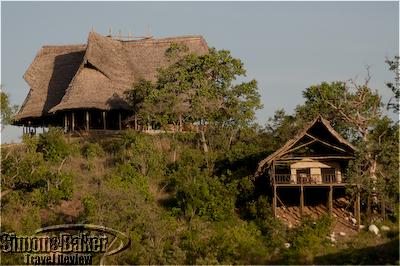
Main lodge and tent at Stanley’s Kopje
The fourth largest national park in the country, Mikumi, was the first stop on my visit to Tanzania and the start of my southern itinerary. At the time of my visit it was home to multiple prides of lions as well as a variety of smaller predators and large herds of everything that makes for a gratifying safari. Interestingly it was also the only park readily accessible from Dar es Salaam, a short 90 minute flight, or a half day’s drive away, which made it a favorite with local visitors. Yet I saw few international tourists there.
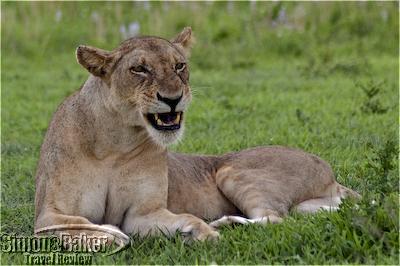
A lioness relaxes in the shade
My home within the park was Stanley’s Kopje, a casual luxury tented camp perched on a rocky knoll with a sweeping view of the Mkata Floodplain that is Mikumi’s core. It was an ideal place to relax after the long international journey and reacquaint myself with the thrill of the African bush. From the comfort of my private veranda high on the hill, I enjoyed lazy post game drive hours watching herds of buffaloes lumber their way across the plain, and elephants converge toward their favorite watering hole.
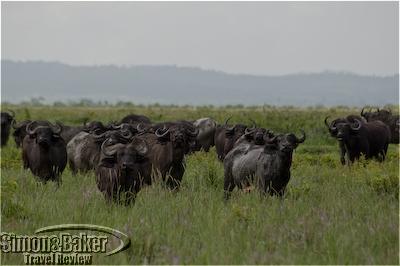
Cape buffalo with the Udzungwa Mountains in the background
Meanwhile on the horizon a fiery sunset outlined the Udzungwa Mountains. The heady sounds of the bush filled the air, complete with a vibrating roar coming from somewhere at the foot of the knoll. There was hardly a hint of human presence anywhere. I had a fleeting thought of sympathy for the hapless tourists who would never know what they had missed.
Ruaha
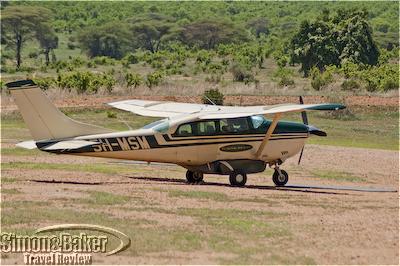
Safari Air Link Cessna lands at the Ruaha airstrip
It was a one hour flight from Mikumi to Ruaha, due west over increasingly high, craggy ridges and agricultural plains. Then the farmland subsided altogether, replaced by forest and rock. We were approaching a rippling plateau, bordered by a steep escarpment, and a dusty airstrip with a welcoming committee of parading giraffes. This was Ruaha, the second largest national park in Tanzania, known for its large population of elephants, giraffes and greater kudus, and for the exceptional diversity of wildlife. And it was all there, for me to enjoy in contented quasi-solitude.
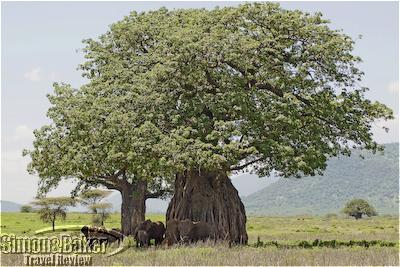
Elephants shade themselves under a baobab
Rarely during a game drive did I catch a glimpse of another vehicle. This would have been sufficient to make for a memorable visit. But there was more. When I think of Ruaha, what I remember most are the baobab trees, hundreds of the ancient giants clustered in colossal groves across the plain, and clinging to the rock all the way up the escarpment. It was a sight I had never experienced anywhere else in Africa.
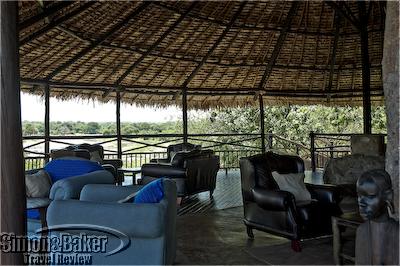
Hilltop lounge at Ruaha River Lodge
And I remember the Ruaha River Lodge, strung across the river that gave it and the park their name. Here, game viewing started at breakfast in the riverside dining room, with a Goliath heron coming to preen at the river’s edge, and baboons bouncing from rock to rock across the water. It continued at lunchtime at the hilltop dining room with a herd of elephants drinking at the rock pool below. Then there were the evenings on the veranda of my banda (Swahili for cottage), in the company of hungry hippos methodically chomping away a few feet beyond my banister.
Katavi
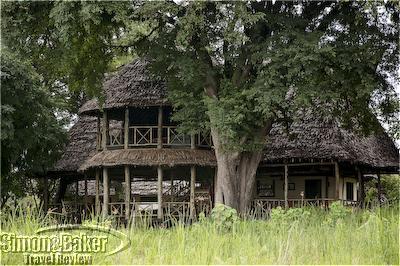
The lodge at Katavi Wilderness Camp
It took determination get to Katavi, the third largest park in Tanzania, a couple of hours’ flight west of Ruaha. It is so far off the beaten track that the park receives only a few hundred visitors per year. Even my Safari Air Link friends flew there only twice per week. But what awaited me there was Africa at its unadulterated best. A rich and varied wildlife going about the rhythm of its existence in a pristine environment of reed-filled floodplains and dense woodlands as it has for millennia. And the Katavi Wilderness Camp.
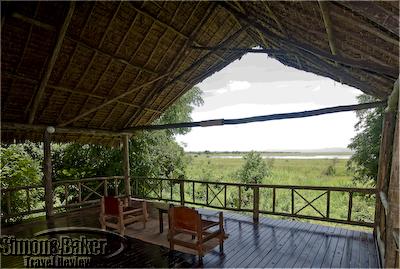
My veranda had a striking view of the Katisunga Plain
Nestled under the canopy of soaring marula and tamarind trees, this intimate luxury camp overlooked the Katisunga Plain as it stretched to the Lyamba-lya-Mfipa escarpment on the horizon. Beyond the wonder of finding an enclave of contemporary luxuries in such an improbable place, what made the camp truly special was its superb staff who welcomed me to a level of gracious hospitality worthy of East African safaris of a bygone era. According to the park authorities, I was one of only three tourists in the park at the time of my visit. I never saw the other two. At Katavi I experienced the intoxicating feeling that, if only for a few days, Africa was mine alone.
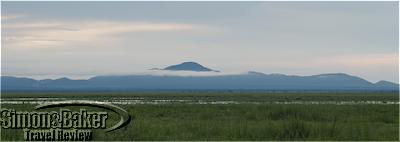
The outline of the Lyamba-lya-Mfipa escarpment emerges from the morning
My travels along the Southern Circuit, aboard the Safari Air Link fleet of nine-seat Cessnas, allowed me a bird’s eye view of the topography of the parks and the countryside along the way. And I was able to experience three impressive, little known game viewing areas, each unique in its own way, and with an even greater variety of game than I encountered later in my trip to the north of the country.
Visit the Simon & Baker Travel Review for more about my recent visit to Tanzania and Stanley’s Kopje, Ruaha River Lodge, and Katavi Wilderness Camp .
by Editor | Aug 22, 2011 | Luxury Travel
Article and photos by Laura Scheiber
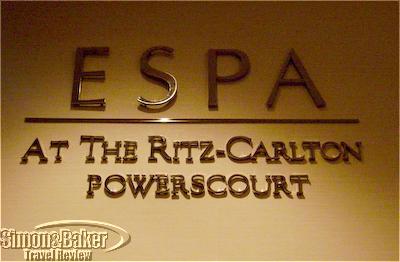
Espa at The Ritz-Carlton, Powerscourt
During a trip to Ireland I had the pleasure of spending a morning at Espa at The Ritz-Carlton, Powerscourt in the lush County Wicklow countryside. Split between two floors, the 33,000 square-foot spa had a fitness room, 20-meter indoor pool, hot-pool, hamman (Turkish steam room), Serenity Room, thermal suites, and 22 treatment rooms. The rustic country setting added to the overall peaceful atmosphere of my visit.
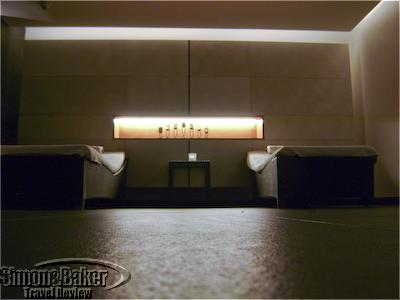
Lounge chairs in the pool area at Espa
I started my morning with a facial from Michelle, one of the sixteen therapists on the premises. She used the Espa house brand of facial products and the treatment included two cleansings, exfoliation, massage, pink mud hair application and mineral masque treatment. Afterward I swam in the elegant pool inlaid with Swarovski crystals, sat in a hot-pool while listening to the soothing sound of a waterfall cascading down a sheet of black slate, and relaxed in a chic eucalyptus-scented hammam. By the time I left the spa, my muscles felt as loose as a wet noodle.
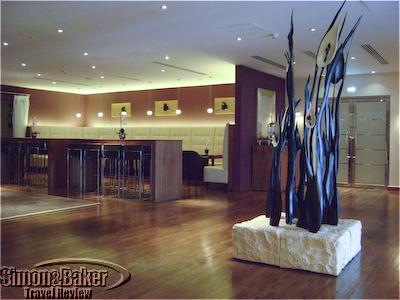
Lobby of Espa at The Ritz-Carlton, Powerscourt
Although the treatment I received was professional and of a high quality, as expected of a spa at The Ritz Carlton, it was the layout and decor of Espa (Powerscourt Estate, Enniskerry, County Wicklow Ireland, +353 1 274 9710, http://www.ritzcarlton.com/en/Properties/Powerscourt/Spa/Default.htm, powerscourtspa@ritzcarlton.com) that set it apart from other spas I have visited. A great deal of thought had gone into creating the perfect balance of modern minimalist design and nature. The elegant interior of low-lit stone, slate and wood, coupled with views of the surrounding mountains made this a unique and serene haven well worth the visit.
by Editor | Aug 15, 2011 | Luxury Travel
Article and photos by Josette King
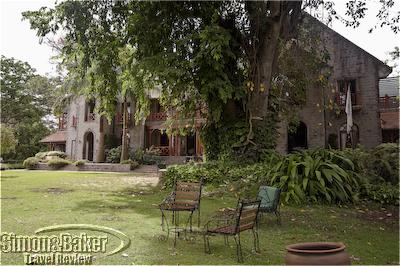
The lodge was a colonial era country manor
Arusha has come a long way since in its origins as a sleepy early 20th century garrison town. Built by Germany as its center for colonial administration of the area, it was then little more than a backwater boma (fortified enclosure) and a few shops in a corner of the northern highlands of what is now Tanzania. A few decades later, the development of commercial air travel, and with it the popularity of mass tourism, changed all that. Ideally located within easy reach of Mount Kilimanjaro as well at the famed safari destinations of northern Tanzania (Serengeti, Ngorongoro Crater and Lake Manyara, a.k.a. the Northern Circuit), Arusha was poised for explosive growth.
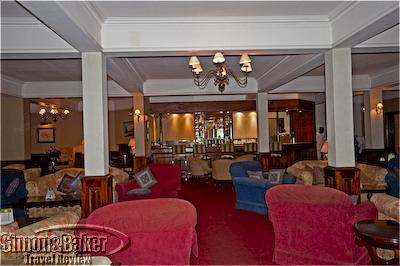
A mahogany-paneled bar occupied the rear wall
Today, with Kilimanjaro International Airport within an hour’s drive, the city has become a necessary stopover for most of the of the 300,000 foreign travelers that arrive there yearly, on the their way to the Northern Circuit via Arusha’s own small domestic airport. Modern international-style hotels are springing up throughout the town, along with all the businesses that cater to tourists; and the colorful chaos inherent in a booming African city of 400,000 inhabitants.
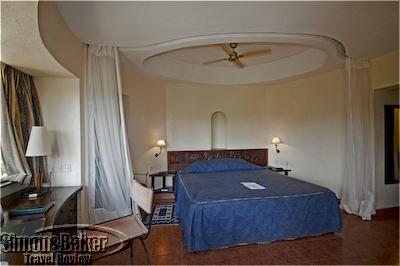
The sleeping area had mosquito netting draperies
However, when traveling to and from the bush my personal choice is for a more serene transition. I had already been in Tanzania for two weeks, visiting the remote parks in the south of the country by the time I arrived in Arusha to enter the Northern Circuit. When lack of coordination between the schedules of the various small local airlines that serve the two areas necessitated an overnight stopover, I turned my attention to hotel options in the outskirts of the city. I was delighted to discover the Serena Mountain Village.
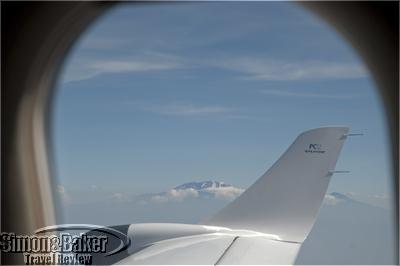
A bird’s eye view of Mount Kilimanjaro
Located on the shore of Lake Duluti in the verdant foothills of Mount Meru, the property was a tranquil luxury retreat a mere 12 miles from Arusha. I loved the English country manor atmosphere of the main lodge, the contemporary comforts of the guest accommodations located in lush gardens overlooking the lake and the warm welcome of the well-trained staff. And when time came for my early morning flight to the Serengeti, I appreciated that Arusha airport was a stress-free 20 minute drive away.
Visit the Simon & Baker Travel Review to read more about Tanzania and my stay at the Serena Mountain Village.
by Editor | Aug 8, 2011 | Luxury Travel
By Matthew Harris
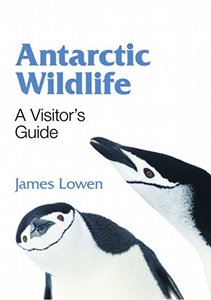
Antarctic Wildlife book cover
Photos: Princeton University Press
The allure of Antarctica’s vast wilderness captures my imagination, particularly as it is home to some of the world’s most beautiful wildlife, living in a pristine environment devoid (mostly) of troublesome humans. Identifying this wildlife can be quite a challenge for amateur and expert alike, so having a comprehensive field guide is a must for the discerning traveler heading south. Antarctic Wildlife A Visitor’s Guide (Princeton University Press, $22.95) by James Lowen is just such a guide, written by an accomplished guidebook author who brings to bear his experience as an Antarctic naturalist guide working for Polar Star Expeditions.
The first part of the book provides information on conservation, choosing an Antarctic cruise, tips on identifying wildlife, and the animals that might be encountered in each of three regions visited on a typical cruise leaving from South America. The second part is a field guide with 155 pages of wildlife identification photos and supporting text.
Having visited Antarctica I found the background information in the first part of the book to be accurate and informative, especially with regard to choosing an ecologically sound cruise and the potential seasickness perils of the infamous Drake Passage. That said, since the main aim of this book is to be a field guide, some may find these sections a bit brief compared to dedicated books on topics such as Antarctic conservation.
The wildlife introduction and identification tips are clear and should be a great help to those new to wildlife observation. One well thought out aspect of the book is that the author summarizes the animals and plants which might be encountered in each of three geographic regions: The Beagle Channel, Drake Passage, and Antarctic Peninsula. These summaries include look up tables the reader can use to jump to more detailed Species Accounts in the main field guide section. Since the vast majority of Antarctic cruises visit these three regions, this layout should enable the reader to identify wildlife quickly in the field.
The book really comes into its own with the main field guide section. Each page has Species Accounts with accompanying photos. The exceptions are especially notable animals which have longer dedicated sections (e.g. Penguins). The text provides details on how to identify each animal as well as interesting tidbits of information called Talking Points. Also included are tables listing rarity, conservation status, species metrics and the area where each animal is typically encountered.
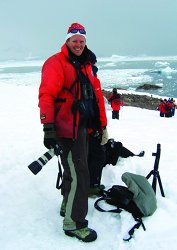
James Lowen, author, Antarctic Wildlife
The identification text is split into two sections, one basic summary for the amateur and beneath this a more detailed description for the avid enthusiast. The supporting images are excellent, chosen for clear field identification, and it’s impressive to note that the author took many of them himself. Overall the list of animals seems comprehensive and covered everything I saw on my trip, plus a host I would hope to see the next time I visit.
This is an excellent field guide, well laid out with photos and easy-to-access information. The guide has good emphasis on conservation throughout and some of the proceeds go to the Save the Albatross campaign. It will definitely accompany me on my next trip to Antarctica.

Click to buy Antarctic Wildlife
by Editor | Aug 1, 2011 | Luxury Travel
Article and photos by Laura Scheiber
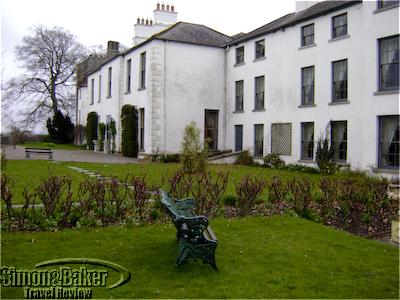
Exterior of Barberstown Castle
When catching an international flight, it is comforting to know that traffic to the airport will not be an issue. Thanks to its location near the airport Barberstown Castle offered this security and also provided a unique experience of staying in a four-star medieval castle previously owned by Eric Clapton.
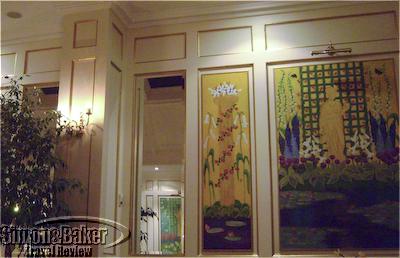
Art in the lobby area of Barberstown Castle
My travel partners and I arrived at Barberstown Castle, located a half hour outside of Dublin city center, in the late afternoon after five days of touring South East Ireland. Candy, a 15 year-old golden retriever who made her home at the castle, greeted us with a wag of her tail as we entered the naturally-lit cheerful lobby. A friendly and unassuming receptionist showed me to room 59.
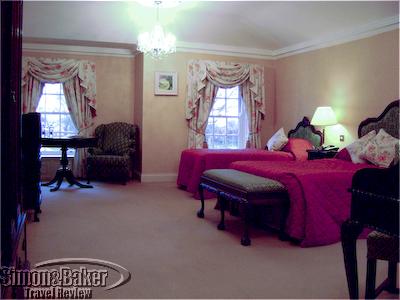
Room 59 at Barberstown Castle
Although the view looked out onto a parking lot, the room was clean and spacious with a double and twin bed. Details that contributed to the cozy ambiance of the room included an attractive glass chandelier and antique furniture that fit the castle setting. As it was a blustery evening, I appreciated the plush bathrobe and towels hanging on an electric towel warmer.
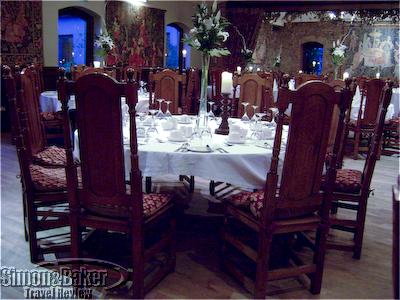
Table used for receptions
Just before dinner, my travel companions and I enjoyed complimentary champagne in the lobby before getting a tour of the castle. Originally built in 1288, the current proprietor, Kenneth Healy, bought the castle in 1987 from Eric Clapton and converted the 10-bedroom guesthouse to 59 bedrooms. While the oldest section dated back to medieval times, additional wings had been added on during Victorian and Elizabethan times. The castle maintained its historic infrastructure and design, and also incorporated modern comforts, such as heating and a pleasant sitting area with large glass windows looking out onto the property’s well-manicured gardens.
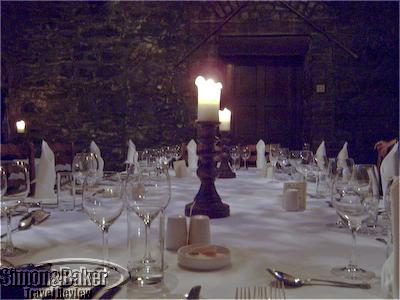
Dining in the 13th century castle
We enjoyed a delicious six-course dinner in the oldest section of the castle. The candle-lit room added to the already enigmatic atmosphere. After dinner we moved to the cozy bar area and enjoyed live Irish music with a professional singer, flutist and traditional Irish bodhran drummer.
The next day we headed to the airport for our return to the United States. The route from Barberstown Castle was on a motorway with no major traffic lights. As promised, we made it to the airport in 30 minutes.
My stay at the castle (Barberstown Castle, Straffan, County Kildare, Ireland, telephone +353 1 6288157, http://www.barberstowncastle.ie/) was a delightful way to wrap up my Irish holiday. The castle’s unique setting dating back from medieval, Victorian and Elizabethan times, the tasty dinner, hospitable staff, live Irish music and close proximity to the airport offered an enjoyable alternative to staying in Dublin city prior to departing Ireland.

































